You must have used a bathtub, a sink, or a toilet with yellow stains. How was the experience? Were you left wondering what causes yellow stains in the bathtub, sink, showers, and toilet bowl?

Well, there is no doubt that mineral deposits are the primary cause of the yellow stains especially when you live in a hard water area.
A bathtub with yellowish streaks looks very unsightly. The thought of taking a bath tends to make one feel disgusted and it’s also very unwelcoming to visitors.
So, what’s the solution? Should you throw the whole tub out and get a new one? Of course not.
Unless all the solutions we shall discuss in this article fail to work, you do not have to purchase another bathtub, sink, or toilet.
Save yourself some bucks and try the following solutions using the right products.
What Causes Yellow Stains in Bathtub?
Hard water is one of the most common causes of yellow stains in bathtubs. The high mineral concentration of calcium, magnesium, etc., leads to yellowing. Witnessing yellow stains in the bathtub is generally due to the composition of the water, scum from the soap, and irregular cleaning. Not only is leaving the yellow stains unhygienic, but it also makes the bathtub area look unpleasing.
What Causes Yellow Stains in Bathtub, Sink, Shower & Toilet Bowl
When people see yellow stains in their bathtubs, they get surprised because they clean these areas often.
What they don’t know is that the yellowing is likely to keep occurring unless they find the cause.
So in this section, we shall talk about some of the main causes of yellow stains in bathtubs, sinks, toilets, and showers.
1. Hard Water
As aforementioned, hard water is the main culprit of the yellow stains in the tub, toilet, or sink.
If you live in a hard water area, this is something you cannot easily prevent.
The yellowing is due to the high concentration of minerals like calcium, magnesium, and iron in the hard water.
There is no doubt that the yellow stains caused by mineral deposits or build-up can be difficult to get rid of.
However, with the right products, as discussed in the next section, you can easily restore the shiny appearance of your tub.
If you are not sure whether your water is soft or hard, try this simple test.
Add a few drops of pure liquid soap into a bottle of water. Shake for a few seconds and check the appearance of the water. If it is cloudy, then you have hard water.
Alternatively, take a sample of your water to be tested by a state-certified laboratory in your area.
2. Tannins in the Water
Tannins are decayed organic matter that finds their way into the water.
Although tannins are not considered harmful, they give water a yellowish color and an unpleasant odor.
As a result, they stain laundry as well as cause yellow stains in the tub, sink, toilet, and shower.
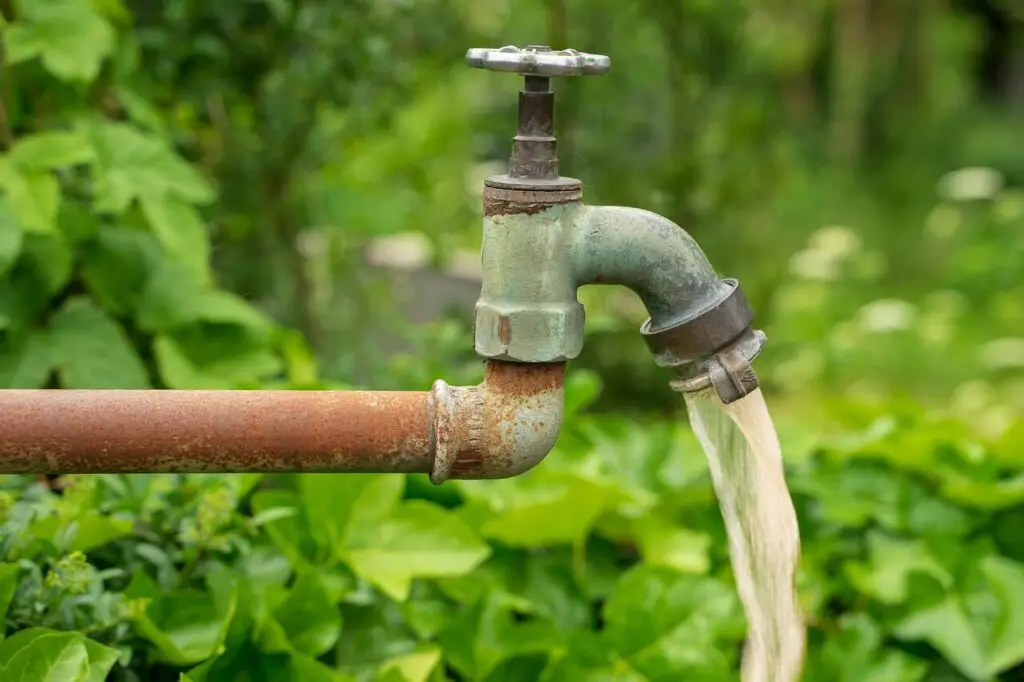
The most effective way of removing tannins from water is by filtration, which we shall talk about in the next section of this article.
Prior to doing this, you need to determine whether or not the yellow stains on your tub are due to tannins or not.
Simply fill a glass with water and let it sit overnight. You will confirm that the water contains tannins if the color intensity remains the same without settling at the bottom.
3. Iron in the Water
Most water systems have iron.
However, if the quantity of iron is more than the recommended amount, it leads to rust.
Rust occurs when iron mixes with oxygen in the water.
You can tell there is rust if you notice a yellow, red, or orange tint in the water, which stains your tub, sink, toilet, and fixtures.
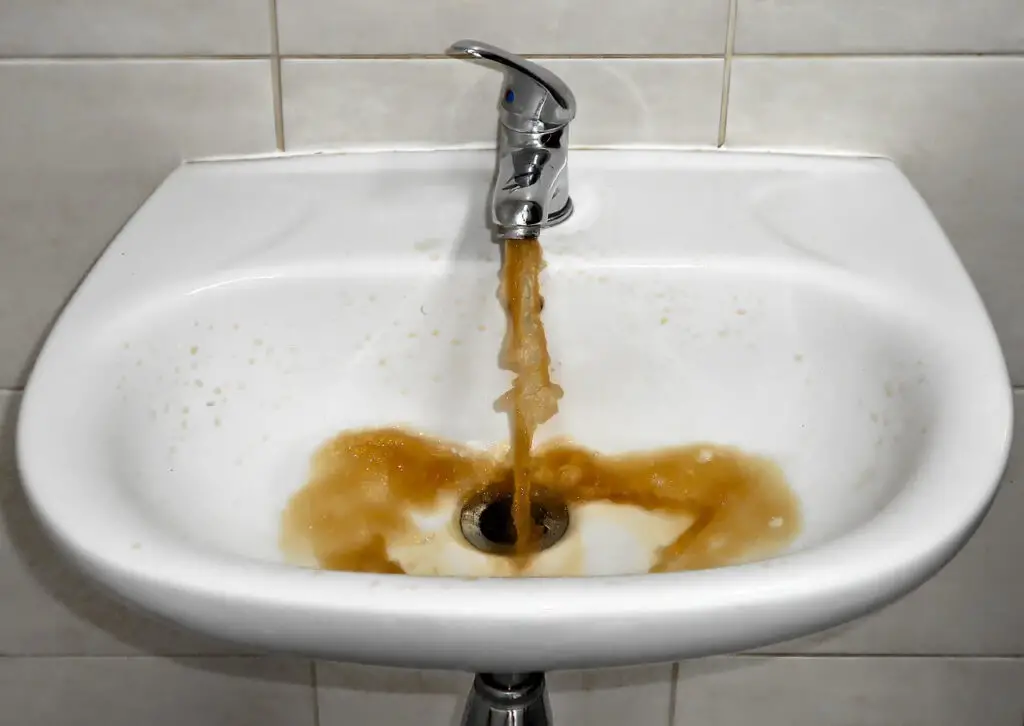
Unlike tannins, rust does not give the water an unpleasant taste or odor.
See also: Best clawfoot tub shower curtain
4. Oil Accumulation from Bath Products
You may say that you don’t use oil in the bathroom, but the products you use might contain oil. For instance, lotion and hair cream might find their way into the tub as you take a shower.
Also, if you use the oil products near the sink or wash your face or hands in the sink, the oil will build up over time and cause stains.
The solution is to ensure you clean the tub and sink after every use with the appropriate products that will remove the oil.
5. Using the Wrong Cleaning Products
While bathroom cleaning products contain strong chemicals designed to kill bacteria and cleanse your bathroom, there’s a chance that you might be using the wrong cleaning products together.
This is especially true for products containing ingredients like wax or oil; these can discolor your bathtub, sink, toilet, or shower.
Once you discover that these products are what causes yellow stains to appear in your bathroom, you will need to remove them using separate products containing bleach and degreasing agents.
How to Remove Yellow Stains from Bathtub and Other Surfaces
The most suitable way to get rid of yellow stains in tubs or surfaces depends on which type of mineral is causing the stains.
Also, it depends on the products you like using and what you can afford.
In this regard, readily available household products like vinegar, lemon, and baking soda are perfect for cleaning various surfaces.
1. White Vinegar


If you have used all cleaning agents without success, try white vinegar. Pour a little white vinegar onto the yellow-stained area, then scrub using a brush.
You can also put the white vinegar into a spray bottle, spray the stained area, wipe with a cloth or rag, and rinse it off.
For stubborn stains, repeat the process until the stain comes out.
White vinegar is perfect for removing stains on delicate surfaces like an acrylic tub.
2. Baking Soda
Baking soda is a household product that is readily available.
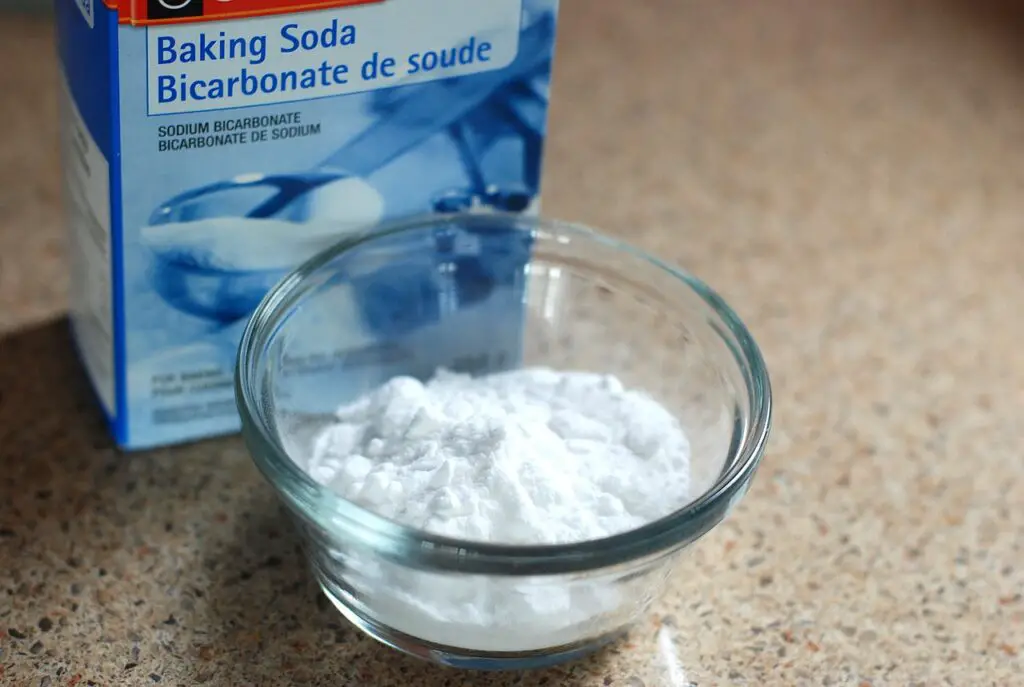
If white vinegar fails to remove the yellow stain, try baking soda.
You can mix it with water or with hydrogen peroxide.
When using water, mix one-quarter of baking soda with 50ml of warm water.
For hydrogen peroxide, use the ratio of 2:1. For instance, mix 2 teaspoons of baking soda with one teaspoon of hydrogen peroxide.
After mixing, apply the paste to the stained area and leave it for 15 minutes. Then, use a scouring sponge to scrub the area and rinse it off with clean water.
Keep doing it until the surface is clean.
See also: Best non slip bath mat for textured tub surface
3. Salt with Lemon
Salt with lemon juice is a cost-effective natural remedy used to dissolve mineral deposits on stained surfaces at home.
Simply mix salt and lemon juice, and then apply the mixture to the affected surface with a sponge.
Wait for a few minutes and scrub off the stains and then rinse with clean water.
4. Scrub Using Whitening Toothpaste with a Toothbrush
In one of the home cleaning forums, someone suggested using whitening toothpaste with a toothbrush to scrub off the yellow stains.
I don’t know how well this technique works but cleaning experts argue that whitening toothpaste has mild abrasives. This means that it can help to remove certain stains on surfaces.
Its application is quite straightforward.
Simply apply the whitening toothpaste to the stained area then use a toothbrush to scrub the yellow stains off.
5. Use Salt and Turpentine


Please try this method only if you have a bathroom with proper ventilation or can open a window fully.
You must also ensure that you have a pair of thick rubber gloves.
To remove yellow stains from the surfaces in your bathroom, combine one cup each of turpentine and salt in a disposable container and mix the two ingredients until they are well combined.
Next, use a piece of cloth or a rag and dip it into the mixture, soaking the cloth thoroughly.
Using the cloth, firmly rub the yellow stains until they disappear, then rinse the varied surfaces with plain water.
6. Use Chlorine


While chlorine is generally used in swimming pools to kill germs and keep the water fresh, you can also small amounts of it to get rid of stubborn yellow stains in your bathtub.
To get rid of the yellow stains in your bathtub, you must sprinkle a generous amount of chlorine on the stains. Let it sit for 30 minutes to an hour. Next, scrub the stains using a brush with soft bristles.
Ensure you wear rubber gloves and protective eyewear while working with the chlorine; you don’t want to get it in your eye. It would be best to try using chlorine only if your bathroom is well-ventilated.
If not, it could be harmful to your health to inhale chlorine, even if it’s only for a short period of time.
7. Cleaners for Hard Water Stains
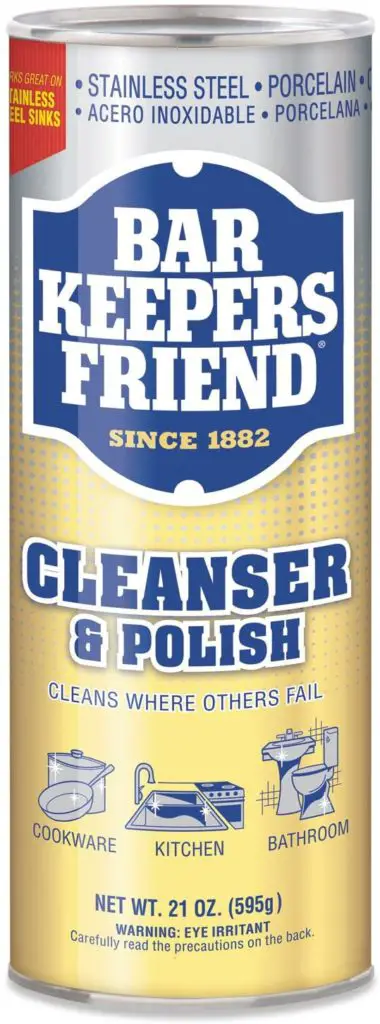

Finally, if all the above household products fail to work, you might have to consider using cleaners designed for hard water stains.
For instance, Bar Keepers Friend Cleanser and Polish comes highly recommended.
Bar Keepers Cleanser is a multi-purpose cleaner that cleans all surfaces including ceramic, glass, marble, stainless steel, and brass.
It is very effective at removing stains in a tub, toilet, or sink as it uses natural acids such as oxalic acid, which is safe on ceramic.
To remove the stain, sprinkle the powder on the stained surface with a bit of water and scrub off with a soft brush.
See also: Best all metal handheld shower head
How to Prevent Yellow Stains on your Bathtub and Other Surfaces
Here are ways to avoid yellowing on your bathtub, sink, showers, and toilet bowl:

1. Clean the Tub After Every Use
To prevent the yellow stains in the tub, you have to clean it after every use.
To achieve this, every member of your family must follow the routine of cleaning the bathtub after use.
2. Ensure the Faucets Close Tightly Without Leaking
When you close faucets tightly, there will be no rust, which is caused by leaks.
If you notice that the water is yellowish, you have to replace the faucet. By doing this, you prevent these surfaces from turning yellow.
Also, make sure water is not running out of the shower or leaking out of it.
3. Add Water Softer to Your Water
A water softener helps solve the hard water challenges.
As aforementioned, hard water causes yellow stains on ceramic surfaces.
But if you add a water softener to it, you will say bye to yellow stains and save your energy, time, and money.
4. Use the Whole House Ironshield Filtration System
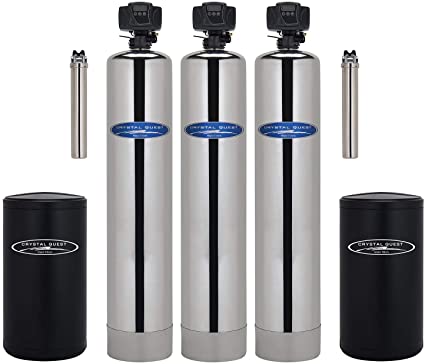

This is the perfect solution for filtering out tannins, removing excess iron, manganese, and other harmful products in your water.
For instance, the Crystal Quest Tannin Water Filters are designed to automatically remove tannins from water as well as soften hard water.
They have 2 tanks.
The first tank is connected to the mainline of your home so that it can filter all the water that is coming while the second tank contains a softer one that removes the water hardness.
FAQs
Yellow stains on bathroom sinks can be caused by various different things.
These include hard water, oils that accumulate from the products you use, and even iron in the water.
If none of these factors apply to you, then the yellow stains might be the product of tannins in the water supplied to your home.
The three main ingredients that you can use to get yellow stains out of your shower are white vinegar, baking soda, and salt.
You can use them in a combination with each other, or you can use them separately, and they will successfully get rid of the yellow water stains.
In the same way that you would use a combination of baking soda and white vinegar to get rid of stains in your shower, you can use those two ingredients to remove yellow stains from an enamel tub.
Conclusion
Are you still wondering what causes yellow stains in the bathtub, sink, shower, and toilet bowl?
In this article, we have discussed all the possible causes such as hard water, tannins, oils, and iron in the water.
To get rid of the stains, try white vinegar, baking soda with hydrogen peroxide, salt, and lemon, or cleaners for hard water stains.